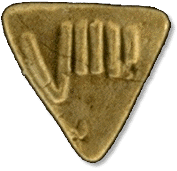The Coming of the Aryans
Parpola proposes a new theory about when, from where and how the Aryans came into the Indian sub-continent and the identity of the Dasas (Dasyus) who were their traditional enemies. According to this theory, the Rigvedic Aryans were preceded by another wave of Indo-European speaking invaders who called themselves the Dasas and who penetrated further to the east than did the Rigvedic Aryans.

The new theory is based on textual-linguistic re-interpretation of the Vedic evidence in the light of the recent remarkable discoveries made by Soviet archaeologists of a previously unknown Bronze Age civilization in Bactria (North Afghanistan) and Margiana (in Turkmenistan). The Bactria-Margiana Archaeological Complex (BMAC) had two distinct cultural periods, the first between 1900 and 1700 BCE and the second between 1700 and 1500 BCE.
Token from Harappa
According to Parpola a small wave of Aryan-speaking nomads from the northern steppes arrived in this region in BMAC-I period and adopted the local non-Aryan culture while retaining their own Aryan language. Parpola identifies their name as Dasa from Old Persian inscriptions and Greek and Latin sources. The presence of the horse and evidence for the practice of chariot warfare by the ruling elite appearing at this time in Bactria confirm the Indo-European origin of the Dasas. The fortified palace at Dashly-3 with three concentric circular walls belonging to this period is identified by Parpola typologically as tripura, 'triple fort' of the Dasas in Vedic mythology.
Parpola suggests that the Dasa-Aryans from BMAC arrived in South Asia via Baluchistan during the time of the Late Harappan cultures, as evidenced by the typically BMAC graves and cenotaphs at Mehrgarh and other sites on the Kachi plain near the Bolan Pass. According to him these early 'Indian Dasas' are likely to have become the ruling elite in the Late Harappan cultures: the Cemetery-H culture of the Punjab, the Jhukar culture of Sind, and the Ochre Coloured Pottery culture of the Ganga-Yamuna Doab.
Parpola also proposes that a second wave of Indo-European speakers from the northern steppes swept over the Bactria-Margiana region in about 1700 BC. Evidence for this comes from the distinct break between the cultures of BMAC I and II at this time. Parpola identifies the newcomers as 'Sauma-Aryans' from their ritual of Soma drinking which the 'Dasa-Aryans' did not practice. Evidence for Ephedra (identified as the Soma plant) has been discovered in the residues of liquid in ritual vessels found in the temple-forts of Togolok-21 and Gonur-I in Margiana dating from the BMAC-II phase.
The Sauma-Aryans too would have largely adopted the local culture, but also transforming the cult of the Asura-worshiping Dasas into the Deva-worshiping cult involving the Soma ritual.
After the fusion of the two peoples, one group of the unified Proto-Indo-Aryans migrated eastwards into the Swat valley founding the Proto-Rigvedic culture.
Parpola's new hypothesis will have to be examined in detail by specialists in South Asian history and Indo-European linguistics. So far as the Indus Civilization is concerned the main implication of the new theory seems to be that the Aryan-Dasa conflict recorded in the earliest portions of the Rigveda is the story of the hostilities and eventual fusion of two Aryan tribes, which took place before their entry into the Indian sub-continent and has thus no relevance to the demise of the mature phase of the Indus Civilization.
